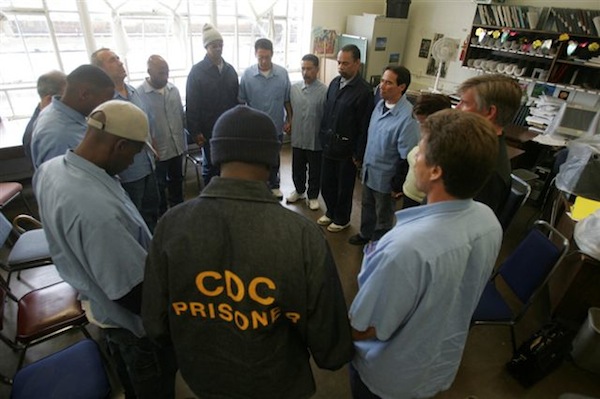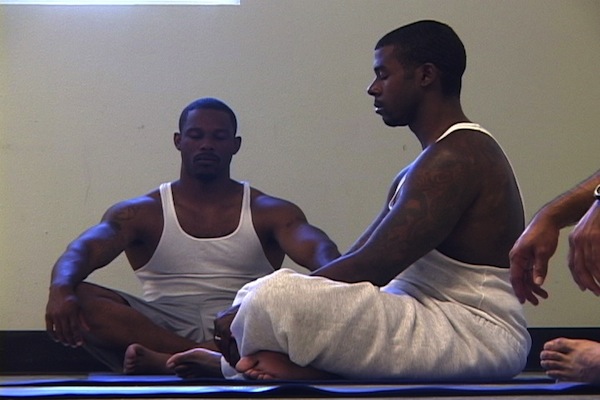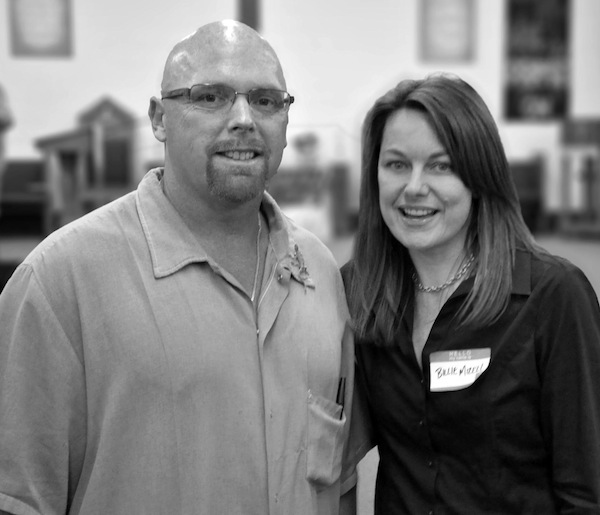A dozen men sit in a circle. Some are old and some are young. A facilitator asks each one to check in with the group about how they are feeling emotionally, physically, or spiritually. Sometimes a man tears up with emotion as he talks. The others listen, offering nods of support or asking clarifying questions.
 Dionne Wilson's husband was murdered. Today, she helps inmates to empathize with crime victims.
Dionne Wilson's husband was murdered. Today, she helps inmates to empathize with crime victims.
It sounds like a typical men’s support group—until you know these men are all prisoners incarcerated at San Quentin Prison.
This is a Victim Offender Education Group (or VOEG), an outgrowth of a movement that aims to help people who’ve committed crimes take responsibility for the harm they’ve caused others and to make amends to the victims of crime and their community. Operating within the criminal justice system as an alternative to punishment alone, these “restorative justice” programs help prove that personal transformation is possible, even for people who’ve committed the most serious crimes.
Restorative justice models have come about because of a growing recognition that the criminal justice system is warehousing large numbers of people—disproportionately, African Americans, Hispanics, and the poor—and tearing apart communities while failing to make them safer. Not only does restorative justice offer deeper levels of engagement and rehabilitation, many argue it’s more cost effective, produces less recidivism, and is more satisfying to victims of crime than the current model.
The VOEG is a project of the Insight Prison Project (or IPP), which began in 1997. The program aims to help incarcerated men learn new emotional skills and correct problem behaviors in order to succeed in and out of prison. IPP offers a multipronged approach to personal transformation, including classes in violence prevention, yoga, and mindfulness. It also brings victims and survivors together with inmates, so that the men can be exposed to the human impact of the types of crimes they’ve committed.
The process doesn’t just help the inmates to grow. It can also help the survivors. “When you’re sitting across from a person who has pulled the trigger and ended another person’s life, and you are telling them about your child attending their father’s funeral, you see the impact on that man,” says Dionne Wilson, whose husband, a police officer, was killed in the line of duty. “That helps to heal me.”
IPP now operates in 12 state prisons, one federal prison, three county jails, several reentry facilities, and one juvenile institution—and the demand is growing.
 VOEG circle.
VOEG circle.Confronting yourself
Robert Frye is a graduate of IPP who was recently released from San Quentin after serving 26 years of a 25 years-to-life sentence for an armed robbery that resulted in a homicide by his codefendant. He first heard about VOEG after taking a meditation course offered at San Quentin prison and felt attracted to the introspective, “self-confrontative” aspects of the program.
“For many years during my incarceration, I had a lot stuff I wasn’t dealing with,” says Frye. “So, when I saw what they were doing, I said this is something I need to do for myself.”
He and the other prisoners went through an intensive, yearlong program designed to help them open up, learn to trust each other, and take greater responsibility for the harm they’ve caused. They explored how crime impacts everyone—not just the direct victims, but the victims’ spouses, children, parents, and communities—while developing empathy for victims through directed exercises. They also learned about the effects of childhood trauma and abuse and how these experiences may have impacted their personal psychology, all the while developing skills like emotional regulation and anger/stress management.
“One of the things I’ve learned, which has been invaluable, is the difference between a reaction and a response,” says Frye. “If you give yourself just one moment to ask yourself how this is going to turn out and to do a little processing before you actually say something bitter or negative, you can respond better and not be reactive.”
Frye’s experience with the VOEG group culminated in a meeting with a panel of spouses and mothers of crime victims—people like Dionne Wilson—who spoke to the men about their personal experiences of pain and loss. The men also shared information about their crimes, answered questions for victims if they could, and tried to explain why they did what they did. For Frye, this was probably the most powerful part of the program.
“It was very cathartic to witness the many survivors that were broken and hurt, and to be able to share my story with them,” he says.
After going through the IPP program, Frye trained to be a facilitator himself and led several groups at San Quentin before being released. He says that, as a leader, he’s seen some prisoners come into the program in denial—which he turns into an acronym: “Don’t Even Notice I Am Lying”—but that the program creates a safe space for them to let down their defenses and begin to open up to each other.
“I’ve seen guys that were coming with almost no insight into themselves, but still have the program strike a chord,” he says. “Being able to share their story of victimization with the direct survivors of a similar crime…you just see the positive change that happens, and it’s reciprocal.”
 Meditation with the Insight Prison Project.
Meditation with the Insight Prison Project.But does it work?
Initial research on restorative justice programs like VOEG, in which perpetrators are willing to participate, show that the programs are effective at both reducing recidivism and increasing victim satisfaction with the justice process.
A recent meta-analysis published in 2013 has found that programs that include offender/victim dialogues had a significant decrease in post-release recidivism and was cost-effective—up to 14 times more so—when compared to the costs of the crimes prevented. Victim satisfaction with the handling of their cases was also uniformly positive.
The effectiveness of IPP specifically, though, is hard to evaluate directly for a number of reasons. One is that it is composed of many different sub-programs, which Frye argues is necessary given that different prisoners respond to different aspects of the program. In addition, prisons don’t always support research, because of restrictions about how prisoner information can be shared.
Still, an unpublished pilot study with juvenile offenders at the detention center Camp Sweeney found that those who went through the IPP program had significant decreases in anger and increased pro-social self-appraisal after completing the program.
In another study of IPP at San Quentin, prisoners who’d been in the program for 6 months or longer reported higher levels of self-esteem and social support, more favorable problem-solving skills, and decreased aggression and hopelessness than those who’d been in the program less than six months. Though these changes were not statistically significant, the researchers note that they do support a “dose-response” to the program.
Healing childhood trauma
 Sonya Shah
Sonya Shah
For Sonya Shah, director of curriculum for VOEG, the program’s effectiveness is tied to the connections the prisoners make between the harm they’ve caused and the harm done to them as children. She points to evidence showing how childhood trauma deeply impacts a person’s development.
For example, a 2007 large-scale study conducted by the Center for Disease Control and Kaiser Permanente, involving over 17,000 people followed over several years, found that children who experience traumas like physical or sexual abuse, or who live in a home where a parent is being battered, experience many adverse consequences, including a higher risk of future substance abuse and an increased tendency toward violence.
“A child has few resources to cope with trauma,” say Shah. “Without a strong attachment to a caregiver, unprocessed trauma will likely lead toward either turning on oneself, through substance abuse or cutting, or turning on others, through violence and abuse.”
Neuroscience research supports her contention. In one recent study that used MRI technology to look at the brains of traumatized adolescents, researchers found that these adolescents had a “heightened sensitivity to conflicting emotional information and a lack of regulatory control over emotion processing” than adolescents without a history of trauma, which put them at greater risk for later adult pathology.
Shah says that much of what the VOEG facilitators do in their program is to connect the dots for prisoners. She wants them to understand how their own early victimization may have led to problems with emotional processing that likely played a role in their substance abuse and criminal behavior.
“We like to say, ‘Hurt people hurt people,’” says Shah. Not that this excuses the crime they’ve committed, she adds; but it helps the prisoners see that they are part of a cycle of violence.
Billie Mizell, the director of IPP, has seen this cycle firsthand. Before joining IPP, she spent years working in the criminal justice system as an investigator where she would interview men who’d been convicted of a crime and investigate their backgrounds as part of the penalty phase of the trial. She found that people convicted of violent crimes had uniformly been victims of abuse and neglect themselves, often from multiple sources.
“Without exception, in each one of these cases, I found horrifying evidence of childhood abuse,” she says. “Time after time, I’d interview social service workers and they’d tell me that this case was one of the worst they’d ever seen.”
This information often gets lost, though, in the rush to get a conviction, she says.
 Robert Frye and Billie Mizell
Robert Frye and Billie MizellIs restorative justice fair to victims?
After her husband was murdered in 2005, Dionne Wilson became very angry, and “hated everything and everybody.” All she could think about was vengeance, she says.
But, four and a half years after the trial that convicted her husband’s killer and gave him the death penalty, she was more angry and depressed than ever. The promise of closure and relief that she‘d been promised never materialized. That’s when she began to explore other options, like Buddhism and forgiveness practices, which culminated in her writing a letter of forgiveness to her husband’s killer.
After that, Wilson says, “I was able to fully let go of all of that pain and anger, and to move forward and do something positive with my experience.”
She soon found herself involved with VOEG, volunteering to talk with inmates who’d committed murder or other violent crimes. Her first visit to a women’s prison in Chowchilla convinced her that she had a lot to learn.
“I thought I knew who was in prison,” she says. “I thought they’re just bad people who did horrible things and belonged there. But I had it all wrong. “
Instead, she saw how the prisoners were victims, too, and that many felt remorse for their crimes. She soon began volunteering on survivor panels at San Quentin—the prison where her husband’s murderer now sits on Death Row. Although she has not come face to face with him, she has been able to tell her story of loss to other prisoners, and she feels that participating in VOEG is helping to end the cycle of violence by preparing prisoners to be better citizens—either within prison or out in the world when they are eventually released. It’s also been personally satisfying for her.
“It’s so hard to describe what it’s like to have a giant man, the scariest man imaginable, sitting across from you, crying and saying, ‘I’m so sorry,’” says Wilson.
While not all victims may find healing through dialoguing with offenders, and the goal is not necessarily forgiveness, many victims find it more satisfying than traditional forms of justice. Yet, some critics argue that the focus on transforming offenders and rebuilding relationships, rather than directly helping victims of crime, is problematic.
According to Susan Herman, Executive Director, National Center for Victims of Crime, restorative justice programs fall short when they don’t consider the ongoing needs of victims—for example, financial help, counseling, escort services to help them feel safe in their communities, or other types of assistance needed to recover from the trauma of their losses. In remarks made at the International Symposium on Victimology, she says:
My hope would be that someday, when a crime occurs, in addition to holding offenders accountable, we would also ask, “What do victims need?” and “How can offenders, communities and society at large help victims rebuild their lives?” From a victim’s point of view, that would be justice.
Though the program at San Quentin cannot really meet victims’ needs for restitution, it does do its part to encourage prisoners to make amends. Those still incarcerated can contribute to the prison community by volunteering in IPP or simply role-modeling better behavior toward others on the prison yard. Those who are paroled often become involved in community work to lessen violence.
Turning the paradigm on its head
Frye is someone who has decided to give back. Not only has he led groups inside prison, but, since being released 10 months ago, he’s volunteered from the outside to train other facilitators to work in the program. Mizell says she knows dozens of men like Frye who’ve helped the program directly or have worked in their communities to turn off young people to crime. In the past year that she’s been director of the program, there has been zero recidivism for prisoners who’ve graduated from IPP and been released, which she feels directly adds to public safety.
Still, in her mind, the success of the program is not in the statistics, but in the individual lives it has helped to save.
“I get to experience a little miracle almost every day,” she says. “Someone calls me up to tell me that one of the men has graduated from our program, he’s out now, he’s living well. All of the guys who’ve gone through our program are giving back to the community in huge ways.”
Mizell, says it means a lot to her that some of the biggest fans of the program are those involved directly with prisoners—guards and other prison officials who see the benefits of IPP. Shah agrees.
“When the prisoners appear before the Parole Board, the commissioners often say to the prisoners, ‘Go back and do IPP’,” says Shah. That, and the testimony of prisoners who’ve graduated, has helped IPP to have a 3-year waiting list of prisoners wanting to participate.
Now that Frye’s been released, he has a steady job and a fiancé. His life behind bars is over, and he says he is happy, which he owes in large part to IPP.
“As human beings, we’re a culmination of so many different things, and we’ve been impacted by so many different things,” he says. “What’s so great about VOEG is it creates a safe place for intimacy amongst peers of men—which a lot of times is taboo in prison—and empowers them to make the necessary changes. We’re turning the dominant paradigm on its head.”



Comments